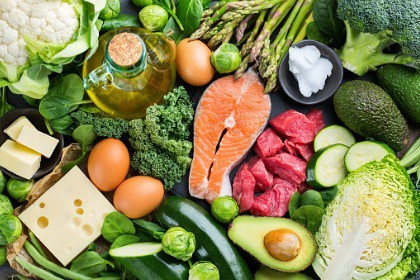Keto Diet vs. Alkaline Diet (Is a Keto-Alkaline Diet the Best of Both Worlds?)
In a hurry? Click here to read the Article Summary...
The ketogenic diet has become a popular go-to for millions of people who are trying to shed pounds, overcome a chronic illness, or simply live a healthier and more energetic life. But aspects of the keto diet appear to conflict with other natural healing protocols like the alkaline diet that promises similar potential health benefits. This begs the question: when it comes to the keto diet vs. alkaline diet, which method is best? And is it possible to blend the two eating approaches into a keto alkaline diet?
The short answer to this question is yes! Keep reading for some helpful tips for how to go about creating your own keto-alkaline diet plan.
Many Keto Foods Are Highly Acidic
Getting your body into a state of ketosis by consuming minimal carbohydrates and plenty of healthy fats and proteins can help to balance your metabolic state, thus supporting the remediation of a range of associated symptoms [1].
However, many prominent keto foods (e.g., bacon and meat in general) fall into the alkaline diet’s “acidic” category, meaning they could wreak metabolic havoc on your body [2].

The keto diet – as it’s often put into practice – can be far from perfect. Loading up on bacon, pork rinds, and processed cheeses might work to bring your body into ketosis, or a fat-burning state, and help you shed a few pounds in the short term. But this way of eating completely neglects the alkalinity element of what many health advocates believe is necessary for a healthful diet.
As a result, some keto dieters can inadvertently increase their risk of developing acidosis, which in turn can lead to chronic inflammation and obesity – two things that the keto diet is meant to counteract. That’s because some keto (low-carb) foods, when consumed in excess, have a net acidic effect inside the body… which is bad news for maintaining metabolic balance.
While some inflammation can be helpful, too much of it (i.e., chronic inflammation) is a recipe for the very diseases that many people who adopt the keto diet are trying to overcome. This is why it can be beneficial to incorporate as many alkaline-forming foods into your keto protocol as possible while avoiding acid-forming foods whenever you can. Or at a mimimum adding in more alkaline-forming foods to counteract the acidic-forming foods.
Benefits to Getting Alkaline First and Going Keto Second
Since meat is a key component of many keto protocols, this is often the biggest roadblock for folks trying to maintain a state of both ketosis and alkalinity. That’s because meat generally contains high levels of arachidonic acid, which can be both inflammatory and acid-forming [3].

But this can be successfully mitigated by focusing first on alkalizing your body with alkaline diet foods before going all-in on keto. This approach involves consuming more alkaline-forming foods like fresh vegetables and fruits, leafy greens, and fibrous plant foods while avoiding processed sugars and flours, as well as conventionally raised meat and dairy products.
After achieving a state of alkalinity (which some health experts say you can determine using urine pH test strips [4]), omnivores might choose to reintroduce healthier types of acid-forming foods such as free-range, pasture-based meat products and wild fish. Both of these foods are notably higher in inflammation-fighting omega-3 fatty acids [5] than their conventional, factory-farmed counterparts.
Two Approaches to Balancing a Keto-Alkaline Diet
While there isn’t a one-size-fits-all approach that will work for everyone, one way to approach an alkaline keto is to rotate back and forth between the two diets, starting with alkalinity as your baseline.
Some health practitioners believe that staying in ketosis for too long can potentially lead to internal acidity and that it’s important to take occasional breaks. If you choose to follow this approach you could focus on your body’s alkalinity during these breaks. Once this is reestablished, you could then shift back towards the keto side of things; alternating between the two dietary styles.

A second approach to a keto alkaline diet would be to aim for an 80/20 diet. This is where you consume roughly 80% alkaline-forming foods, which could be made up primarily of low-carb vegetables. The 20% acidic foods could come from grass-fed meats, which are rich in complete protein, and healthy fats (e.g. olive oil and raw nuts) that promote ketosis.
Intermittent Fasting Can Help
Another way to push your body into a state of ketosis without having to constantly overload it with acid-forming foods is to eat all of your alkaline-forming, keto-promoting meals within a set window of time every day and dedicating another chunk of time each day for sustained fasting. This is known as intermittent fasting.

Evidence suggests that intermittent fasting further encourages the body to look for energy from things like fat rather than glucose, which will encourage your body to naturally burn fat as it’s nudged towards a ketogenic state – oftentimes regardless of what you’re actually eating during your “feeding window.”
In other words, when you restrict your eating to that intermittent period, it becomes far less critical to maintain a strict keto diet in order to stay in ketosis. This, in turn, will give you more leeway to instead focus on maintaining your alkalinity or just living your life, as opposed to trying to perfect your keto regimen, which is difficult for some.
Don’t Forget Hydration, Sleep & Stress Management
You can diet all day long and still not see results – or worse, see anti-results (e.g., weight gain) – if you’re not paying attention to your total life balance. Burning the candle at both ends, not drinking enough water, and worrying all the time are among the unhealthy lifestyle habits that will more than likely kill your best efforts to implement an effective keto alkaline dietary protocol.
Fitting in quite nicely with intermittent fasting, full nights of uninterrupted sleep are equally, if not more, important than eating all the right foods at all the right times.

The same holds true for consuming plenty of clean, filtered water daily, and managing your stress levels. Stress is a major contributor to cellular breakdown, as it can increase the body’s cortisol load and damage insulin sensitivity, potentially leading to obesity and metabolic abnormalities [6].
Risks Associated with Prolonged Ketosis Are Reduced When Combined with an Alkaline Lifestyle
Alkalizing your keto protocol may not only make it more effective, but it can also minimize the risk of side effects which keto critics often cite. This includes an overproduction of ketones that overwhelms the body’s acid-base buffering system, potentially leading to muscle fatigue and eventual breakdown.
This scenario is typically a consequence of diabetic ketoacidosis stemming from type-1 diabetes as opposed to nutritional ketosis brought about through diet. But some experts warn that a strict keto diet can potentially cause similar complications in some people, which is why incorporating an alkaline element into your keto protocol is highly recommended.

One study found that breaking up a longer period of keto dieting into two significantly smaller ones, with a “maintenance Mediterranean diet” in between (a Mediterranean diet being highly alkalizing), resulted in improved weight loss and metabolic markers, with no harmful side effects [7].
5 Tips for Optimizing Your Keto Alkaline Diet and Lifestyle
- Avoid eating starches (e.g., potatoes, grains) at the same time as meat.
- Choose raw fruit instead of heated or cooked fruits and consume fresh, raw fruits on an empty stomach – berries being your best option [8].
- Cleanse your body regularly, focusing on detoxing your liver to rid it of all the pharmaceuticals, food preservatives, and other chemicals that have accumulated in it, as well as throughout your body.
- Consume plenty of potassium-rich foods such as avocado and broccoli as potassium is a powerful, natural defense mineral that protects against body acidity.
- Minimize your intake of low-quality animal protein, especially the kind that comes from factory farms. It can increase sulfuric acid buildup in your blood as the amino acids are being broken down and assimilated, which creates acidity.
A Closing Note on the Keto Diet vs. Alkaline Diet
Keep in mind that everybody (and every body) is different and what works for one health expert or diet guru may not work for you. That’s why, when it comes to any eating style, experimenting with how YOU feel and what your health markers show is the best way to determine the right approach for you.
The latest formula of Organic OrganiGreens is our best yet. In just one simple scoop, add 17 organic superfoods and botanicals, plus probiotics and enzymes, to your daily diet to fill nutritional gaps and support healthy immune function, increased energy and mental clarity, as well as digestion and detoxification processes. Easily mixes in water, smoothies, juices, and recipes, and it also tastes great – even without any added sugars.

 Sources:
Sources:
Article Summary
The ketogenic diet is very popular with people trying to shed pounds, overcome a chronic illness, or simply live a healthier and more energetic life.
Some aspects of the keto diet appear to conflict with other natural healing protocols like the alkaline diet. Fortunately, it is possible to blend the two eating approaches into a keto alkaline diet.
Some keto (low-carb) foods (e.g., bacon, cheese, and meat in general) have a net acidic effect inside the body. Incorporating as many alkaline-forming foods into your keto protocol as possible can help to counteract acidic-forming foods.
This approach involves consuming more alkaline-forming foods like fresh vegetables and fruits, leafy greens, and fibrous plant foods while avoiding processed sugars and flours, as well as conventionally raised meat and dairy products.
Another way to push your body into a state of ketosis without having to constantly overload it with acid-forming foods is through intermittent fasting.
Sleep, hydration, and stress management are critical for success with any diet plan.
5 Tips for Optimizing Your Keto-Alkaline Diet & Lifestyle are:
- Avoid eating starches (e.g., potatoes, grains) at the same time as meat.
- Choose raw fruit instead of heated or cooked fruits
- Cleanse your body regularly
- Consume plenty of potassium-rich foods
- Minimize your intake of low-quality animal protein




Very informative and well written. The topic is so timely. I have an acid system and have frequent acid reflux despite eating all veggies. I do like meat but plan to eat less as it causes acid, a fact I did not know until I read your article.
Hello Shirley! We are sorry to hear about your acid reflux and we hope you are getting better now. We are pleased to know that this article gave you an idea on how to handle and understand your diet based on your current health condition.
We would love for you to take a look at our blog at https://organixx.com/health-articles/ that features other posts about acid reflux, just like this one: https://organixx.com/enzyme-deficiency/.
Thank you for your feedback and we wish you the best in your wellness journey!
Hi thank you for your comments on those type of diets. I never been on a diet, because I have sensitive stomach and small, but for other people who need this informations, is good advice. Keep the good work.
Thank you for your feedback, Kathleen.
Glad to hear you enjoyed the article. We appreciate you being here with us. Hope you have a wonderful day!
Love the simplicity and clarity of this article. So much confusing information about different approaches each of which promises miracles and encouraging you to use this particular one or another. Thank you for providing us with information that shows the benefits of both and how to combine them. I particularly like the summary of tips at the end.
Hi Barbara! Thank you for your feedback. We're so happy to hear that you loved this article.
Thank you so much for being a part of the Organixx community. We hope you have a great day!
So refreshing!! Most post here are obviously for people who have a lot of spare time in he day. For working people it is impossible to read everything interesting that comes in as it can take 30-40 minutes to watch a video that could have been explained in bullet points. A very interesting topic, I am a badly controlled diabetic. Thank you
Hi Michelle, thank you for your feedback. We're glad to hear that you liked this article!
We understand how some of our readers are in a hurry and do not have the time to completely read the whole post. This is why we have created a summary in bullet points at the end of the article. You may read it under the Sources and before the Comments section.
We hope this helped and we wish you the best in your journey towards wellness!
how does Organixx organigreen powder fit into a keto/alkaline diet? Will it "break" my 16 hour intermittent fast if I have a scoop in water in the morning ? When is it best imbibed when doing timed eating? So happy to see you addressing these issues.
Thanks!
Hello Carol, thanks for your question.
There are many different ways to approach intermittent fasting as we discuss both in this article (https://organixx.com/how-to-intermittent-fast/) and in this podcast with Jon & TeriAnn (https://organixx.com/empowering-you-organically/fasting-healthy-or-harmful-episode-40/). It may interest you to know that we have members of the Organixx team who practice intermittent fasting and like to use OrganiGreens as a gentle way to break their fast and wake up their digestive system before eating anything heavier. OrganiGreens can be consumed at any time of day; before a meal, with a meal, or by itself. One scoop of our OrganiGreens powder has 6g carbs and 3g fiber, so it can readily fit into a low-carb eating plan. Plus, if you look at the ingredients list you'll see the long list of alkaline-forming plant foods which comprise OrganiGreens.
If you are interested to refer the OrganiGreens to a nutrition or medical specialist, you may use the following links:
Product Information- https://organixx.com/organic-organigreens/
Enlarged Supplement Label- https://cdn.shopify.com/s/files/1/1569/1827/products/Organixx-OrganiGreens-Sweetened-label-back.png
FAQ- https://support.organixx.com/166339-OrganiGreens
We hope you found this helpful! Have a great day!